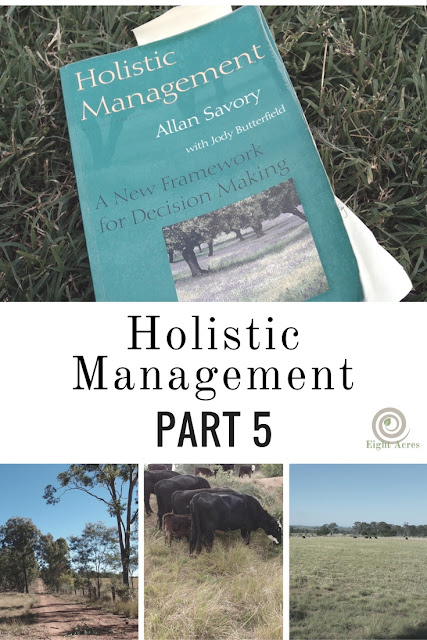Holistic Management - part 5: tools for managing ecosystem processes
The book Holistic Management: A New Framework for Decision Making (affiliate link) sets out a guide to developing a holistic goal for your farm or business.
In Part 5 of the book takes that understand of ecosystem processes and discusses the tools that we can use to manage ecosystem processes in brittle and non-brittle environments. These tools include:
- Money and labour
- Human creativity
- Technology
- Rest
- Fire
- Grazing
- Animal impact
- Living organisms
Human Creativity
"Every situation requires management that must be an original product of human imagination, and even that must evolve as the situation changes". Creativity to adapt to changing environments is therefore the land manager's greatest tool. Unfortunately many farmers rely on agrichemical company representatives to tell them how to farm, observing their land from the air-conditioned cabs of huge tractors, they are disconnected from ecosystem processes, and do not trust themselves to creatively solve management problems without external inputs. I think this is where Permaculture is also useful, with principles such as "observe and interact" it encourages creative thinking rather than formulaic one-size-fits-all solutions. The success of creativity depends on an accurate understanding of the environment, even a highly creative solution can cause chaos if the underlying processes are not well understood,
Fire
Fire is a powerful tool for modifying our environment. Savory suggests that overuse of fire and rest is leading to desertification in brittle environments, which is a reminder that fire should be used very carefully. One of the arguments for the use of fire is that many of the Australian plants are fire-resistant and have therefore evolved to withstand frequents, however this ignores the fact that once abundant fire-sensitive plants are now extinct due to the use of fire by ancient aboriginal people.
The effects of fire include:
- exposing soil surface by removing both vegetation and leaf little (and therefore vulnerable to erosion, makes rain less effective at penetrating the soil)
- permanently destroying fire-sensitive vegetation, favouring fire-resistant vegetation, reduces diversity
- Impact on native animals as habitat is destroyed and diversity reduced
- Carbon in the soil burns (forms carbon dioxide) and is lost from the mineral cycle
Rest
Either in the form of total rest (all livestock removed) or partial rest (extensive livestock operations where animals are spread out over large areas), if not used appropriate this tool can also cause damage. Often we allow damaged land to rest in order to recover, however this may not actually help in brittle landscapes. Old plant material decays very slowly due to lack of moisture, which can cause grasses to die out. Rest tolerant plants are often unproductive and unpalatable. Animal impact is actually needed in these situations to break down plant material (in the rumen of livestock) where it would naturally decay in less brittle (wetter) landscapes. The effect of rest depends on the degree of brittleness. Where we live, the landscape moves along the brittleness scale from year to year.
Sometimes we have high rainfall and resting a paddock will result in lush, thick grass cover. Other years if we have very low rainfall for several months, that same paddock will be full of unproductive, sparse clumps of dead grass. Knowing how much rest is needed under certain conditions before it becomes detrimental and reducing the occurrence of "partial rest" by keeping paddocks small (i.e. rotational grazing methods) is important in brittle landscapes. One of the best ways to rejuvinate an over-rested area is to bring cattle in for a short period, confined to small areas with portable panels or electric fence and feed hay bales, manure and hay will get trampled into the dead grass and help to kick-start a productive decay cycle.
This mirrors the herding and moving on behaviour of large ruminants in nature which have maintained productive grasslands over centuries, and the basis of mob-stocking (Joel Salatin) and other rotational grazing concepts. Savory also notes that the condition of rested land is an indication of the brittleness of the landscape. I know we have a lot of bare patches on partially rested areas of our property, which confirms my assessment that we are usually very brittle.
Grazing
By manipulating the timing and intensity of grazing we can use it to our benefit rather than causing damage. Grazimg must be considered in conjunction with animal impact, the next section. In this case, grazing itself refers to the eating of grasses and other types of vegetation, even through bushes and forbes are technically "browsed" rather than grazed. The point at which grazing becomes "overgrazing" depends on weather the vegetation is annual or perennial, grass or non-grass and the type of grazing animal.
While short-lived annual plants are never really overgrazed (as they die off each season anyway), perennial grasses, which are so important for soil cover in brittle environments, are susceptible to overgrazing. Grasses have growth points close to the ground and actually benefit from having old growth removed by grazing, either early in the growing season or when the plant is dormant. However, if the grass is grazed too frequently in the growing season it will fail to recover. As I wrote in a post back here (actually just after I had first learnt about holistic management), the grass has to use energy from its roots to regrow each time and will gradually lose root-mass if it is grazed repeatedly before it can recover. Therefore, overgrazing is defined as " any grazing that takes place on leaves growing from stored energy at the expense of roots, rather than directly from sunlight". By contrast, "grazing" as a tool is the appropriate use of animals to eat grass and other plants, to the benefit of those plants, without overgrazing. Slashing or mowing can be used instead of grazing (as per Peter Andrews).
Grasses with runners, such as Rhodes grass and Blue grass are less likely to be overgrazed than bunching grasses such as Panic and Digit grass. This is because the running grasses spread horizontally, so less leaf is removed per root mass.
Grazing can be used to improve diversity of plants, encourages vigorous growth and reduces fire hazard as old dead growth doesn't accumulate. Water and mineral cycles are enhanced through greater root mass. Overgrazing tends to have the opposite effect.
In an extensive grazing system (large area with few animals) some plants can be overgrazed and others over-rested in the same paddock, as animals return to the same plants to nibble the tasty regrowth. Therefore it is the time that the animals have access to an area and not the number of animals that is important (as discussed in part 2: four key insights). This is where the ideas of rotational grazing or Joel Salatin's "mob-stocking" are useful, as you can mimic the effect of large herds, bunched together by predators and moving regularly to new pastures.
Our property was overgrazed when we had too many animals during drought conditions a couple of years ago (cattle prices were really low, so we held them a bit too long which we waited for the market to settle and then sold all of them). We were lucky to have rain since then and with no animals on the land and non-brittle conditions, the rest allowed the grasses to regrow. Now we risk over-resting because we only have fewer cattle on the property. It seems that we need to vary stocking rates depending on the year. We also need to set up rotational grazing, we are working on making smaller paddocks and thinking about how we split them up using electric fencing.
The one problem I have with rotational grazing is that all the examples I have are from non-brittle environments. Joel Salatin, my favourite house cow blog "Throwback at Trapper Creek" and even fellow Australians Peter Andrews and Darren Doherty, are all using this system in less brittle environments. But we will come to this later in the book.
Animal impact
Animal impact refers to everything else that animals do apart from grazing - dunging, urinating, salivating, rubbing, and trampling. This tool fits nicely with permaculture principles, considering how we can let nature (specifically farm animals) replace machinery or chemicals to remove overgrown vegetation, fertilise and disturb and shape compacted land to improve the land. The idea that cattle (and other stock) might actually help the land was also covered in more detail in the book Can cows save the planet? Certainly the way that cattle are fed intensively in feedlots is NOT contributing to saving the planet, but cattle in a well-designed and managed rotational grazing system will improve the land. In fact, in a brittle environment, where there is not enough humidity to sustain microbial breakdown of plant material, ruminants (cattle, sheep, goats etc) are essential for cycling nutrients in the environment.
Living organisms
While the previous two tools used living organisms, this is also a separate tool to encourage the consideration of biological solutions before technology. Again, this fits with permaculture principles. "Failure to think along these lines accounts for much of the environmental damage humans have wrought". This tool is closely linked to the ecosystem process of community dynamics, i.e. if you develop community dynamics through biodiversity, you will have the tool of living organisms to use, and if you use the tool you will develop the ecosystem process further. This is the oldest tool, the most complex, and the one that has been too often abandoned in favour of technology, to the detriment of all the ecosystem processes. When we raise animals or crops for our own advantage, we forget that they exist within an ecosystem, and rely on technology to control predators, pests, competitors, and disease, instead of working with the entire system.
Technology
The problem with technology is that its easy to "consider only the problem at hand without thought of larger implications". Most technology has some side-effect, from minor issues to pollution, leaching, erosionnnn, extinction, deforestation etc. Conventional agriculture relies heavily on technology, including machinery (tractors, bulldozers, excavators) and chemicals (herbicides, pesticides, fertilisers, vaccines and hormones). While technology has the potential to benefit the land, it must be used very carefully. I refer to permaculture principle "Use small and slow solutions". Technology is usually big and fast, so it needs to be used very carefully. Sometimes a short-term problem may demand the use of technology, but a longer-term view is required. For example, we have been working on various ways to control buffalo fly without chemicals, but our poor cow Molly reacts terribly to fly bites and we have used chemical ear-tags on her the past couple of summers while we find something natural that works for her. The flies will eventually become resistant to the chemical, so this is a short term relief for our cow while we figure out the long term solution
That is a very brief overview of the tools in holistic management. The next section is about testing decisions, how we decide which tools to use to work towards our holistic goal. This is where we will really get into the specific methods that we will use on our property. What do you think? Do you use these tools effectively?
Joel Salatin's books
Peter Andrew's books on Natural Sequence Farming
Permaculture Principles





















Leave a comment